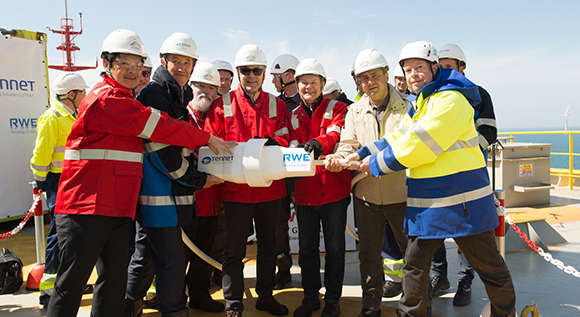Tailwind for offshore: two new windfarms go on line in the North Sea
First "Dan Tysk," then "Nordsee Ost": two offshore windfarms comprising a total of 128 wind turbines have gone on line off the coast of Schleswig-Holsteins in recent weeks. In the years to come, the two windfarms could supply more than 700,000 households with clean, climate-friendly electricity.
 Inauguration of the "HelWin alpha" converter platform and the "Nordsee Ost" windfarm on the occasion of the G7-Energy Ministers Conference: the photo shows (from left to right) Shigeki Iwai (Vice-Minister of Economy, Japan), Mel Croon (Tennet Holding B.V.), Miguel Arias Cañete (EU Commissioner for Energy), Torsten Albig (Premier of the state of Schleswig-Holstein), Olaf Scholz (Mayor of Hamburg), Federal Minister for Economic Affairs and Energy Sigmar Gabriel, Peter Terium (RWE) © BMWi/Maurice Weiss
Inauguration of the "HelWin alpha" converter platform and the "Nordsee Ost" windfarm on the occasion of the G7-Energy Ministers Conference: the photo shows (from left to right) Shigeki Iwai (Vice-Minister of Economy, Japan), Mel Croon (Tennet Holding B.V.), Miguel Arias Cañete (EU Commissioner for Energy), Torsten Albig (Premier of the state of Schleswig-Holstein), Olaf Scholz (Mayor of Hamburg), Federal Minister for Economic Affairs and Energy Sigmar Gabriel, Peter Terium (RWE) © BMWi/Maurice Weiss
Tailwind for wind energy on the high seas: after the windfarms in the German North Sea and Baltic having reached the milestone of 1,000 megawatts (MW) of total installed capacity at the end of 2014, another 288 megawatts just recently went on line with "Dan Tysk" and 295 megawatts with "Nordsee Ost." In all, as much as 3,000 megawatts of wind energy capacity off the German coasts could be connected to the grid by the end of this year – trebling the on-line offshore generating capacity within a year. The 2014 Renewable Energy Sources Act (EEG) has set a target of 6.500 megawatts for offshore wind power by 2020, ten years later the figure is to be 15,000 MW. That will make wind energy off the German coasts more and more a mainstay of our power supply.
Most of the German windfarms are relatively far from the coastline: the 80 wind turbines in "Dan Tysk," for instance, are around 70 kilometres west of the island of Sylt, "Nordsee Ost" with its 48 offshore wind-powered generators of the multi-megawatt class lies 35 kilometres north of Heligoland. There the installations have to withstand extremely harsh conditions – production, shipment and erection call for a dedicated logistical infrastructure of their own.
In service, the offshore units afford a significant advantage over similar installations on land. As wind speeds at sea are higher and the wind blows nearly every hour of the year, they can generate on average up to 40 percent more output. That makes their yield more predictable, reducing the cost of storing electricity and the need to keep alternative capacities in reserve.
Cable and converters: getting the power to shore
To be able to transport the electricity generated offshore to the consumers, new grid connections are needed. Together with the "Nordsee Ost" windfarm, the "HelWin alpha" converter platform was also started up on 11 May against the backdrop of the G 7 Energy Ministers Conference (see Article): there the alternating current from two North Sea windfarms is converted into direct current. This enables the electricity to be transported via a high-voltage direct current (HVDC) submarine cable with low transmission losses over the more than 130 kilometres to shore – where it is converted back into alternating current for feeding into the German transmission grid.
Reform of the EEG helps offshore achieve a breakthrough
At the inauguration ceremony for the "Dan Tysk" windfarm in Hamburg on 30 April, Federal Minister for Economic Affairs and Energy Sigmar Gabriel stressed the economic significance of expanding offshore power generation: "With last year's reform of the Renewable Energy Sources Act (EEG 2014) we have created the certainty investors need and helped offshore to achieve a real breakthrough. 15 gigawatts of offshore generating capacity are to be installed by 2030 – that means investing billions in windfarms and infrastructure, with a high proportion of German added-value content." Just the 3,000 megawatts of capacity that will probably have been installed by the end of 2015 represents an investment of 13 billion euros. "We have invested in grids, have upgraded our ports to cope with the unprecedented logistical challenges, expanded production capacities for wind turbine-generators, towers, foundations and converter platforms. Going forward, on-line operation, too, will provide long-term and sustainable value creation especially in the coastal regions," Gabriel said.
The offshore sector expects the cost of wind energy technology to drop further in the coming years as it becomes increasingly industrialised: more advanced turbines and foundations are being developed, likewise the logistics for installation and maintenance. At the same time, the growing international market is creating learning-curve effects, production costs are falling. Even today, nearly 19,000 people are working in the offshore wind energy sector in Germany.

